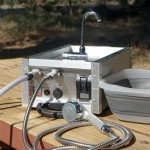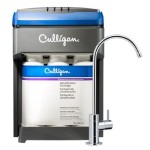```html
Removing Stains from Stainless Steel Sinks: A Comprehensive Guide
Stainless steel sinks are a popular choice for kitchens due to their durability, resistance to corrosion, and sleek appearance. However, despite their robust nature, stainless steel sinks are susceptible to staining and discoloration over time. Food particles, hard water deposits, and everyday use can leave unsightly marks that detract from the sink's original luster. Fortunately, with the right techniques and cleaning agents, removing these stains and restoring the sink's brilliance is achievable.
Understanding the composition of stainless steel is crucial for effective stain removal. Stainless steel derives its resistance to corrosion from the presence of chromium, which forms a passive layer of chromium oxide on the surface. This layer protects the underlying steel from reacting with oxygen and other elements. However, this passive layer can be compromised by harsh chemicals, abrasive cleaners, and prolonged exposure to certain substances, leading to staining and potential corrosion. Therefore, employing appropriate cleaning methods that are both effective and gentle on the stainless steel is paramount.
Identifying Common Types of Stains on Stainless Steel Sinks
Before embarking on the stain removal process, accurately identifying the type of stain is essential. Different types of stains require different cleaning approaches. Here are some of the most common types of stains found in stainless steel sinks:
Water Spots: These are perhaps the most prevalent type of stain, caused by mineral deposits left behind when water evaporates. Hard water, in particular, contains high concentrations of calcium and magnesium, which contribute to the formation of stubborn water spots.
Rust Stains: While stainless steel is resistant to rust, it is not entirely immune. Small iron particles from cookware or other sources can adhere to the sink's surface and, in the presence of moisture, lead to the formation of rust stains. These stains appear as reddish-brown or orange discolorations.
Food Stains: Food particles, especially those containing strong pigments like coffee, tea, tomato sauce, and spices, can stain stainless steel if left unattended. These stains can range in color from light brown to dark brown or even black, depending on the intensity of the pigment and the duration of exposure.
Grease Stains: Grease and oil splatters from cooking can accumulate on the sink's surface, attracting dirt and grime. Over time, these grease stains can become difficult to remove, leaving a sticky and unsightly residue.
Scratches: While not technically stains, scratches can appear as dark lines on the surface of the sink and can trap dirt and debris, making the sink appear stained or discolored. Deep scratches can also expose the underlying steel to corrosion, making them more prone to staining.
Effective Stain Removal Methods Using Household Products
Many common household products can be used to effectively remove stains from stainless steel sinks without resorting to harsh chemicals or abrasive cleaners. Here are some proven methods:
Baking Soda Paste: Baking soda is a mild abrasive and a natural deodorizer that is effective for removing a wide range of stains. To create a baking soda paste, mix baking soda with a small amount of water until you achieve a thick, spreadable consistency. Apply the paste to the stained area, gently scrub with a soft cloth or sponge, and rinse thoroughly with water. For stubborn stains, allow the paste to sit on the surface for a few minutes before scrubbing.
White Vinegar: White vinegar is an excellent cleaner for removing hard water spots and mineral deposits. Dilute white vinegar with water in a 1:1 ratio. Spray the solution onto the stained area and let it sit for a few minutes. Then, wipe the surface with a soft cloth or sponge and rinse with water. For more stubborn water spots, soak a paper towel in vinegar and place it directly on the stain for several hours before wiping clean.
Lemon Juice: Lemon juice, like vinegar, contains citric acid, which is effective for removing stains and brightening stainless steel. Cut a lemon in half and rub the cut side directly onto the stained area. Let the juice sit for a few minutes before wiping clean with a damp cloth. Alternatively, you can squeeze lemon juice into a spray bottle and apply it to the sink's surface. Lemon juice also leaves a fresh, citrusy scent.
Dish Soap: A simple solution of warm water and dish soap is effective for removing grease stains and general dirt and grime. Apply the soapy water to the stained area, scrub gently with a soft cloth or sponge, and rinse thoroughly. For tougher grease stains, let the soapy water sit on the surface for a few minutes before scrubbing.
Club Soda: Club soda is surprisingly effective for removing water spots and mineral deposits. Pour club soda onto a clean cloth and wipe the stained area. The carbonation helps to lift the stains without scratching the surface. Dry the sink with a clean, soft towel to prevent new water spots from forming.
Preventing Stains and Maintaining a Pristine Stainless Steel Sink
Prevention is always better than cure. By adopting a few simple habits, you can minimize the occurrence of stains and maintain the pristine appearance of your stainless steel sink for years to come:
Rinse the Sink Regularly: After each use, rinse the sink thoroughly with water to remove food particles, soap residue, and other debris. This prevents stains from setting and makes cleaning easier.
Dry the Sink: Wiping the sink dry after each use is crucial for preventing water spots. Use a clean, soft towel to dry the entire surface of the sink, including the drain and faucet.
Avoid Abrasive Cleaners: Abrasive cleaners, such as scouring powders and steel wool, can scratch the surface of stainless steel, making it more prone to staining and corrosion. Always use non-abrasive cleaners and soft cloths or sponges.
Avoid Harsh Chemicals: Harsh chemicals, such as bleach and ammonia, can damage the passive layer of chromium oxide on stainless steel, leading to discoloration and corrosion. Avoid using these chemicals in your sink.
Protect the Sink from Sharp Objects: Avoid dropping sharp objects, such as knives and cookware, into the sink, as they can scratch the surface. Use a sink grid or mat to protect the bottom of the sink from scratches.
Clean Regularly: Establish a regular cleaning schedule to prevent stains from accumulating. A quick cleaning once or twice a week will keep your sink looking its best. Use one of the methods described above, such as baking soda paste or white vinegar, to remove any stains that may have formed.
Consider a Stainless Steel Cleaner: Commercially available stainless steel cleaners are specifically formulated to remove stains and protect the surface of stainless steel. Follow the manufacturer's instructions carefully when using these products.
By implementing these stain removal methods and preventative measures, maintaining a sparkling clean and stain-free stainless steel sink is easily achievable. Regular cleaning and careful handling will ensure that your sink remains a shining centerpiece of your kitchen for years to come.
```
How To Clean Kitchen Sink Stainless Steel

How To Clean Chemical Stained Stainless Steel Kitchen Sink

Cleaning A Stainless Steel Sink Going Green With Lisa Bronner

How To Clean Your Stainless Steel Sink Samyx Cleaning

How Do I Remove This Discoloration From Stainless Steel Sink Hometalk

How To Remove Hard Water Stains From Your Kitchen Steel Sink Quick And Safely Cleanings2024

Clean A Stainless Steel Sink Easily With Wd 40 Australia

The Secret To Cleaning Stainless Steel Sinks Like A Pro

How To Remove Stains From Stainless Steel Sink

How To Remove Chemical Stains From Stainless Steel Sink Alpha Building Inspections







